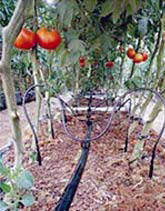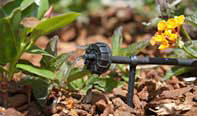
Figure 1 - Drip Irrigation For Tomato Plants
The most important benefits derived from drip irrigation are:
- Reduces water usage.
- Easily irrigates odd-shaped and narrow areas.
- Accommodates hanging baskets and other types of planters.
- May be exempt from water restrictions imposed during drought.
Installation of a drip irrigation system is a relatively easy home improvement. While many homeowners may not consider drip irrigation a home improvement I do! Anything that a homeowner implements to save water is a home improvement. Installing drip irrigation is a home improvement can be accomplished by most home handymen.

Figure 2 - Drip irrigation micro sprayer
The required parts, pipe, fittings, tubing, valves, emitters (nozzles) and controllers to install a drip irrigation system are readily available at most of the Big Box
home improvement centers in both individual units and packaged systems. As well, most landscaping and garden centers now carry a complete inventory of drip irrigation systems and parts.
Drip irrigation utilizes a network of plastic pipes and tubing. Water is distributed slowly, at a low flow and pressure rate to all plants, unlike sprinkler style irrigation systems, which always end up over spraying
the areas that need watering.
Selection of drip irrigation systems.
A normal in-ground sprinkler system has an efficiency of between 50 and 70 percent, whereas a drip irrigation system should provide efficiencies in excess of 90 percent, providing the systems watering scheduled has been considered and programmed properly.
Plant growth is highly improved with drip irrigation because it inherently maintains a proper balance of air and water in the soil around the plants roots. With drip irrigation water is not supplied in excess quantities, it is delivered often and at low flow rates keeping the soil continually moist. Sprinkler irrigation systems have the inherent problem that produce a much more dramatic wet to dry variation in the soil and hence restrict plant growth.
Drip irrigation systems have been available to commercial growers involved in vegetables, orchards, nursery plants and greenhouses for many years. As with many products and systems originally designed for commercial use, drip irrigation has been packaged and re-engineered for residential applications. In home landscaping drip irrigation systems provide exceptional service in vegetable, herb and flower gardens and can be readily adapted to provide watering for fruit trees and hanging baskets.
If you are considering adding or currently have a berm or mound in your landscaping, drip irrigation provides the most efficient and effective method of watering any associated plants. Any slope in landscaping is difficult to water as large quantities of water run off prior to soaking into the ground. By using the low flow rates associated with drip irrigation on a berm or mound, water is more likely to soak into the soil than run off.
